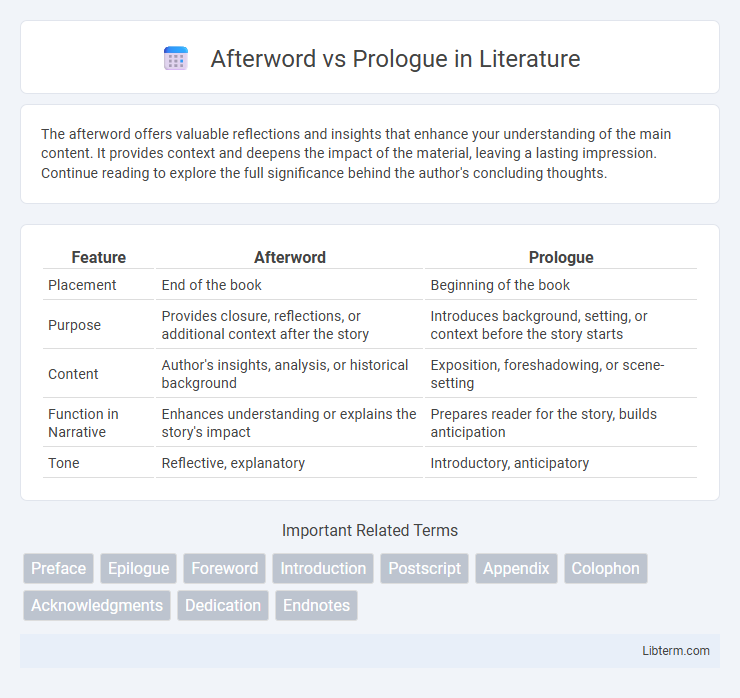The afterword offers valuable reflections and insights that enhance your understanding of the main content. It provides context and deepens the impact of the material, leaving a lasting impression. Continue reading to explore the full significance behind the author's concluding thoughts.
Table of Comparison
| Feature | Afterword | Prologue |
|---|---|---|
| Placement | End of the book | Beginning of the book |
| Purpose | Provides closure, reflections, or additional context after the story | Introduces background, setting, or context before the story starts |
| Content | Author's insights, analysis, or historical background | Exposition, foreshadowing, or scene-setting |
| Function in Narrative | Enhances understanding or explains the story's impact | Prepares reader for the story, builds anticipation |
| Tone | Reflective, explanatory | Introductory, anticipatory |
Understanding Afterword and Prologue
An afterword provides readers with reflections or insights from the author following the narrative, often addressing the story's themes, background, or creative process. A prologue sets the stage by introducing key elements, characters, or events before the main narrative begins, offering essential context or foreshadowing. Both sections enhance comprehension by framing the story, with the prologue preparing readers for what lies ahead and the afterword deepening understanding after the conclusion.
Definition of Prologue
A prologue is an introductory section of a literary work that sets the scene, provides background information, or introduces characters and themes relevant to the story. Unlike an afterword, which is written after the main text to offer reflections or context, a prologue serves to prepare readers by establishing the narrative foundation. It often appears before the first chapter and is essential for understanding the plot's initial framework.
Definition of Afterword
An afterword is a concluding section at the end of a book where the author reflects on the work, providing insights or background information that enhances the reader's understanding. Unlike a prologue, which introduces the story or sets the stage before the main text, the afterword serves to offer closure or discuss the book's significance after the narrative finishes. Afterwords often include author commentary, historical context, or responses to readers' interpretations.
Historical Origins
The historical origins of the prologue can be traced back to ancient Greek and Roman literature, where it served as an introductory section to prepare audiences for the narrative or play. In contrast, the afterword emerged primarily during the Renaissance and Enlightenment periods, evolving as a reflective conclusion or commentary appended by the author or editor. These distinct origins highlight the prologue's role in setting context before the story begins, while the afterword provides historical, interpretive, or critical insights following the main text.
Purpose of a Prologue
A prologue serves as an introductory section in a literary work, setting the stage by providing background information, context, or a glimpse into events preceding the main narrative. It enhances the reader's understanding of the story's setting, characters, or themes before the plot unfolds. Unlike an afterword, which reflects on the completed work, the prologue's primary purpose is to immerse readers into the world of the story from the very beginning.
Purpose of an Afterword
An afterword serves as a reflective conclusion to a book, providing insights from the author or editor about the work's creation, context, or impact. It often clarifies themes, addresses reader questions, or updates information since the initial publication. Unlike a prologue, which prepares readers for the story, an afterword offers retrospective commentary and enhances understanding after the narrative ends.
Placement in a Book
The placement of a prologue typically appears at the very beginning of a book, serving to introduce background information or set the scene before the main narrative begins. An afterword is found at the end, providing closing remarks, reflections, or additional context that complements the story or subject matter. Understanding these distinct placements helps readers navigate the structure and intent of a literary work effectively.
Key Differences Between Afterword and Prologue
An afterword appears at the end of a book, providing reflections or additional context from the author, while a prologue is an introductory section at the beginning that sets the stage for the story. The prologue often contains background information or a scene that precedes the main narrative timeline, whereas the afterword offers insights, commentary, or updates post-publication. Key differences include their placement in the book and their function: the prologue prepares readers for the story, and the afterword provides closure or further explanation.
Impact on Reader Experience
The afterword provides closure and reflection, often deepening the reader's understanding and emotional connection to the narrative after completion. The prologue sets the stage and builds anticipation, offering essential background that shapes initial expectations and engagement. Both impact reader experience by framing the story's context, but while a prologue primes curiosity, an afterword reinforces meaning and lasting impressions.
When to Use an Afterword or Prologue
Use a prologue when setting the stage for a story, providing background, or introducing key themes before the main narrative begins. An afterword is suited for reflecting on the story's impact, offering insights, or explaining the creation process after the book concludes. Choose a prologue to enhance understanding upfront; select an afterword to deepen appreciation and context post-reading.
Afterword Infographic

 libterm.com
libterm.com